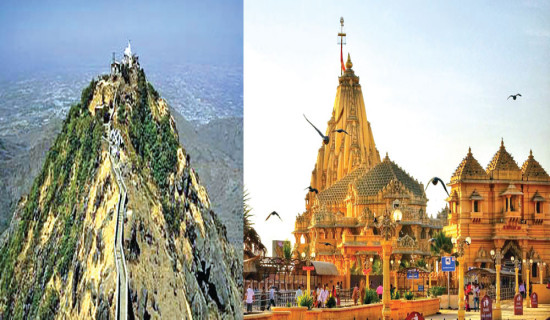- Friday, 16 January 2026
Storytellers Must Set Social Trend
Devi Pratibha Ji, who recently came to Kathmandu from Vrindavan of India to deliver sermon on religion, has been a topic of conversation not only among Nepali households but also in the social media. The 23-year-old Nepali, born in Kavre and initially educated in the village school, developed an interest in reciting the Shreemadh Bhagwat Geeta at a very early age. She continued her education at the Valmiki Vidhyapeet in Kathmandu and later moved to Vrindavan, India, where she furthered her studies in Sanskrit. Now, she is popularly known as a religious storyteller, or kathavachak. Accompanied by six commandos sent by the Indian government for her security, she mesmerised Nepalis, who immediately fell in love with her. She created awe and bewilderment with her captivating storytelling skills, evoking emotions that brought streams of tears from her audience.
However, human rights activists ask how the rights movement can address the captivation of rhetorical values that counteract efforts toward inclusion, especially when today's youth capture the population and re-establish stereotypical norm systems that could be counterproductive. One pressing question is: why did a 23-year-old religious figure need six strong men to guard her in her own home country? Furthermore, if protection was indeed necessary, couldn't the Indian government have provided women security personnel? With the capitalist market-led economy spreading worldwide, the proliferating of religion, culture, traditions, and God's messages has taken a different turn. Instead of fostering spiritual values to maintain faith and lead a peaceful, happy life, religious occasions are being capitalised to mint money for various purposes. Most of the time, they claim it is for charity and good causes, but one can never be sure of the truth.
Fund-raising
The Manavsewa Foundation has organised a month-long kotihom at Pashupatinath Temple during the Hindu auspicious month of Shrawan. Devi Pratibha ji was invited as one of the religious story tellers. This ongoing religious function aims to raise funds for the Mamaghar (maternal home) orphanage in Lalitpur, Choriko Ghar (daughter’s home) and Elderly Home Ashram in Bhaktapur. Notably the elderly homes are now being named 'daughter’s house,' implying that elderly people will receive more care and love at their daughter's homes rather than the houses of son, who inherits ancestral property and is responsible for taking care of the parents. Similarly, naming the orphanage as the home of the mother's paternal home suggests that children receive more care and love there. This indirectly reinstates the fact that in the care economy, childcare and elderly care are better entrusted to daughters and their families.
Shrawan, the fifth month of the Nepali calendar, holds several significances in Hinduism. It starts with the full moon around late July and ends with another full moon towards the third week of August each year, based on the Hindu calendar, which can vary annually as it follows the lunar schedule. This period also coincides with the South-West monsoons in the Indian subcontinent, a time associated with rice plantation and other agricultural activities that significantly impact food security. Food and water scarcity that has plagued humans for centuries is reflected in the religious, cultural, and traditional aspects of human civilisations. Various festivals and worships are tied to events that lead to sufficiency in these essential resources. During Shrawan, Lord Shiva is worshipped by Hindus worldwide.
In Nepal, Shiva is closely associated with climate and weather, his home being the Kailash Parbat or the Himalayas. Nepali children often have fond memories of visiting the Pashupatinath temple for blessings throughout the year. Shrawan was always a sacred month when people avoided non-vegetarian food items. However, a few decades ago, there were no grand events at the Pashupatinath or elsewhere where hundreds of thousands of people gathered to offer money for charity. People practiced charity by feeding the poor and offering homemade savouries to please Shiva for protection of nature, good harvest, and water supply. In Nepal, Shrawan 15th is marked as a day of eating kheer (rice pudding), which is prepared in households, offered to Lord Shiva, and enjoyed by families and friends.
Spiritual values
Nowadays, even before Shrawan begins, the market is flooded with green and yellow clothes, jewellery, and mehendi, a trend that older Kathmanduites may not recall. The commercialisation of religious events leads to spending money on items that hold no real value, shifting the traditionally savings-oriented Nepali society towards consumerism. Given Shiva's value and affection for nature, animals, and the bare necessities of life, youth like Devi Pratibha Ji should emphasise the protection of nature and resources for future generations while avoiding extravagant expenditures. These young leaders are seen as role models for future generations, but they must carefully consider the messages they wish to convey before telling another story.
Youth have the power to influence the minds of their peers. Encouraging spiritual values to spread love and peace in a disturbed and unstable world can be achieved by youth leaders in all spheres of life. The scriptures written thousands of years ago contain many valuable messages for today's world, but they also include several stereotypical value systems that hinder the progress of people based on gender, class, caste, and social values. These outdated values need to be changed and rephrased. Youth icons like Devi Pratibha Ji could help make the world a better place to live by promoting progressive values rather than reinstating counterproductive ones.
(Namrata Sharma is a senior journalist and women's rights advocate. namrata1964@yahoo.com. Twitter handle: @NamrataSharmaP)
















